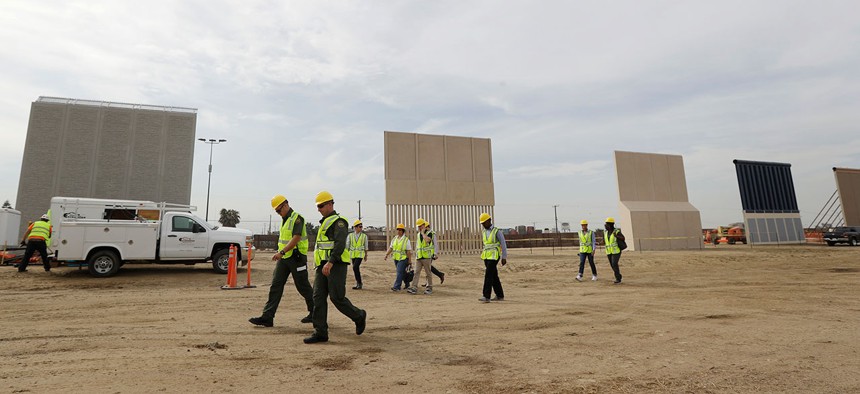
People pass border wall prototypes as they stand near San Diego on Oct. 19. Gregory Bull/AP
The Border-Wall Prototypes Are Up — Now What?
As the administration assesses the projects, both the purpose and effectiveness of a barrier are in question.
Nine months into his presidency, Donald Trump is getting a glimpse of what his border wall, which he made a cornerstone of his campaign, might look like.
Over the course of 30 days, six contractors from across the country worked on eight separate prototypes. The samples, which are located in the San Diego area, differ in the materials they’re made of, as well as in height and design: Four of them are made from concrete, while the other four are made from non-concrete materials; all range between 18 to 30 feet high. The companies that built the prototypes are Caddell Construction; ELTA North America; Fisher Sand & Gravel; KWR Construction; Texas Sterling Construction; and W.G. Yates & Sons Construction.
The projects are the result of a January executive order signed by Trump instructing CBP to build a wall along the southern border, some 650 miles of which already has a variation of fencing. If selected, the prototype, or prototypes, would complement other border-security measures, said Carlos Diaz, a spokesperson for U.S. Customs and Border Protection. But whether a wall is effective at stemming the flow of illegal immigration or the smuggling of drugs all depends on a host of factors, primarily where it’s erected and what purpose it serves at those locations. It could also have symbolic meaning.
The notion of sealing portions of the U.S.-Mexico border goes back several decades. Today, the border still has barriers made of surplus landing-mats from the Vietnam War. In 2006, President George W. Bush authorized the construction of a 700-mile barrier of double-layer fencing on the U.S-Mexico border. “Unfortunately, the United States has not been in complete control of its borders for decades, and, therefore, illegal immigration has been on the rise. We have a responsibility to address these challenges. We have a responsibility to enforce our laws. We have a responsibility to secure our borders,” Bush said at the signing ceremony. The barrier was never completed.
But the thrust of the argument—that a barrier was needed to reduce the flow of illegal entry—is still evident today. Requirements for contractors laid out by the CBP include anti-climb measures to prevent humans from scaling the wall. It also notes that walls should be at least 6 feet deep, in an attempt to impede the digging of tunnels.
Border-security experts argue that while walls may be an impediment to migrants attempting to cross into a country, their purpose is usually largely symbolic. “The scholars who work on walls and immigration security would say that walls in it of themselves are not very effective at stopping movement across the border,” said Reece Jones, a professor of geography at the University of Hawaii and the author of Violent Borders: Refugees and the Right to Move. “It’s much easier for the public, for voters to understand the concept of border security and of changing the security apparatus at the border through the image of a wall rather than talking about all the other sorts of mechanisms used to restrict movement in border spaces.”
Migrants often find an alternative route to take if a barrier has been erected, Jones said, adding that this has been the case not only in the United States but around the world. “In the European Union, as well, as the numbers of walls has gone up, it stopped movement in particular places, but it hasn’t stopped people from trying to cross the border—they just go to a different location and try a different mechanism for crossing,” he said.
By itself, sealing the entire border wouldn’t prevent all illegal immigration. Many undocumented immigrants in the United States also enter the country legally, whether on a visa or through port of entry, and then stay longer than allowed. Nailing down the share of the undocumented population deemed “overstayers” and those who have crossed the border illegally is a difficult task, given that they’re not likely to report either way. But a Pew estimate from 2006 found that nearly half of the undocumented population in the United States overstayed their visa. The other share of the undocumented population entered illegally.
A barrier might not affect the illegal narcotics trade as intended. For one, illegal drugs usually come in through ports of entry. Sanho Tree, a fellow at the Institute for Policy Studies who focuses on drug policies and the border, also expressed concerns about drug traffickers shifting to fentanyl, a potent synthetic drug, if confronted with counter-measures, like a wall.
“It’s a simple market response, it’s what’s happening already, which is to say that traffickers will take whatever heroin can get through and stretch their profits by adulterating it with even more fentanyl, which is much cheaper, much easier to smuggle and its analogues are more compact and more potent and more deadly,” Tree said. “As a result, if the wall does work as advertised, I think you’ll see people dropping like flies at a much higher rate than we have now.”
A wall isn’t the sum of Trump’s vision for border security—he has also called for an increase the number of border patrol agents—though it serves as an important component. “The wall is a deterrent and the wall is the first element on that system that those who are trying to come in get to see and have to navigate,” Diaz said. “It slows people down.”
This week, the agency posted a video on Twitter highlighting a decline in border apprehensions across sectors on the U.S.-Mexico border, which CBP attributed to infrastructure, technology, and agents. For example, the San Diego sector, where the prototypes have been built, dropped from 560,000 in 1992 to 68,000 in 2010. Notably, however, the number of border apprehensions is also on the decline. Former Department of Homeland Security Secretary John Kelly noted this in his testimony before a Senate committee earlier this year, saying that CBP has seen a “sharp decline in apprehensions.”
The review process, which will get underway after the concrete cures, will span 30 to 60 days. “Right now, what we’re focusing [on] is seeing how those prototypes work and if the designs are going to be feasible and how they hold up against the requirements that we provided in the RFP, which includes anti-dig, anti-climb, and anti-breach, and other capabilities,” Diaz told me, referring to the agency’s proposals. He added that CBP could choose one of the designs, all or several of them, features to create a hybrid, or discard them altogether.
The reason behind the use of several designs along the southern border is a result of the different types of terrain. In remote areas, with difficult topography, erecting a wall may not be feasible, said David Aguilar, the former deputy commissioner of CBP who now works at Global Security and Innovative Strategies. He added that urban areas, on the other hand, often need a barrier, as a result of increased activity. See-through barriers are also generally preferred by border patrol agents because they allow agents to see what’s happening on the other side. Two of the prototypes fall under this category.
Trump’s 2018 budget calls for $1.6 billion to begin building new sections of the wall and replacing existing barriers. But the money is only a fraction of the cost. The White House projects that sealing the southern border could cost between $8 and $12 billion, but the Department of Homeland Security estimates it could cost as much as $21.6 billion.
In July, the House approved a spending bill that allocated nearly $1.6 billion for a border wall. It’s unclear whether it’ll pass the Senate or how much more funding, if any, the administration will receive to move forward with a wall, as Democrats oppose its construction and Republicans have been apprehensive about publicly supporting it.
Of course, any progress on a border wall, whether presenting new designs or erecting them over a swath of land, might be enough to satisfy Trump supporters, many of whom favor a barrier. It also might appease Republicans, in general: According to a Pew Research Center survey, 74 percent of Republicans backed a border wall, compared to just 8 percent of Democrats. A barrier could provide a sense of security or action—with or without reducing illegal immigration.
NEXT STORY: Washington Resumes Talking About Nuclear War







